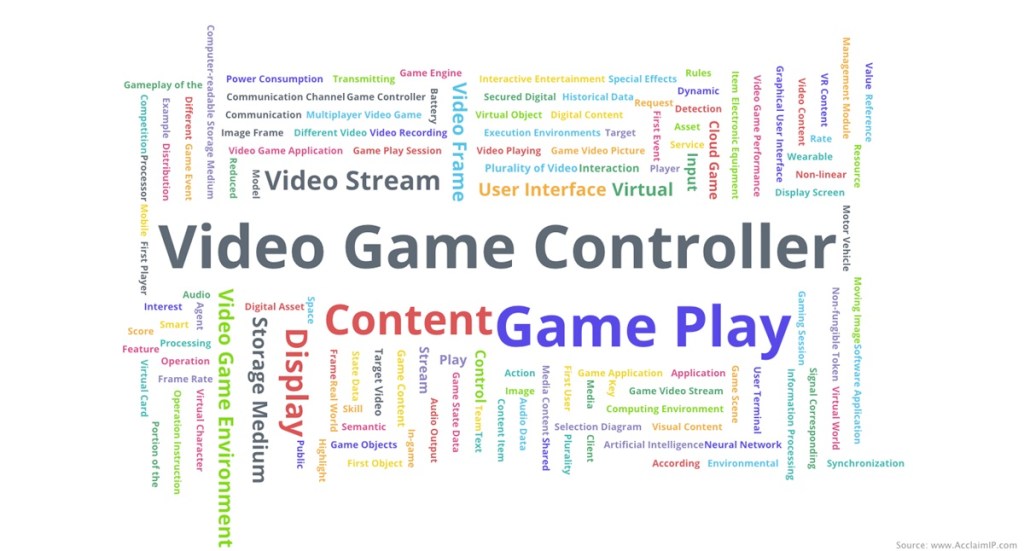Sony leads the global gaming giants in terms of filing for patents around the globe, according to a study by Anaqua’s AcclaimIP patent search and analytics software.
Anaqua said global gaming giants, particularly Sony Interactive Entertainment, have emerged as major players in patent filings, fueling innovation across multiple facets of gaming.
In fact, Sony filed over five times the number of patents as its closest competitors last year, with 117 patent applications. Companies like Activision and Electronic Arts (EA) trail with 22 and 21 applications, respectively.
Khyle Eaton, senior manager for IP Counsel at Anaqua, said in a blog post that the key areas driving the video game industry forward are mobile and hand-held devices, streaming and latency technologies, and cybersecurity measures. This patent activity is a clear reflection of the direction in which the gaming industry is moving – towards portable, seamless, and safer gaming experiences, Eaton said.
Join us for GamesBeat Next!
GamesBeat Next is connecting the next generation of video game leaders. And you can join us, coming up October 28th and 29th in San Francisco! Take advantage of our buy one, get one free pass offer. Sale ends this Friday, August 16th. Join us by registering here.
The evolving landscape

Mobile and hand-held gaming has recently emerged as the most popular segment of the industry. Last year alone, the global mobile gaming market generated $184 billion in revenue (according to market researcher Newzoo), underscoring its tremendous growth over the past decade.
Anaqua looked at mobile and hand-held gaming-related patent filings from 2001 to 2024. While
the chart includes data for 2021 and beyond, it’s important to note a temporary decline in patent
representation, as filings have yet to be made public. However, the numbers up to 2021 highlight the innovative momentum driving this sector.
Backbone patent

This rise in popularity is fueled by several factors. First, mobile gaming offers a high level of diversity. Players can switch between competitive first-person shooters, relaxing puzzle games, and virtual poker tournaments – all from the same device. The accessibility of smartphones has also played a pivotal role, with affordable devices like Samsung’s gaming-friendly smartphones bringing high-quality gaming to the masses, Anaqua said.
Furthermore, the expansion of 5G networks has created new possibilities in mobile gaming, enabling seamless connectivity and reducing latency issues. Anaqua’s annual patent report found the U.S. granted 55,263 5G-related patents in 2023, up 3% year over year. This improved infrastructure has paved the way for global competitive gaming on mobile devices, with esports leagues like the Clash Royale League and Call of Duty Mobile Championship gaining traction, Anaqua said.
Recent patents showcase the continued evolution of mobile gaming hardware. Hand-held consoles like the Steam Deck and controllers such as the Backbone are further blurring the lines between traditional console gaming and mobile experiences. Sony’s PlayStation Portal is another example, offering players the ability to continue gaming on the go without sacrificing the quality of the console experience.
Streaming and latency patents
As gaming has moved towards mobile and cross-platform play, streaming technologies and latency reduction have become increasingly important. This is crucial for the growing trend of cloud gaming, where performance hinges on low-latency connections.
Patents in this space are aimed at improving the performance of games across various platforms, including VR headsets, smart TVs, and consoles. These innovations are essential for reducing lag and
ensuring smooth gameplay, particularly for streamed and multiplayer games, Anaqua said.
For example, Sony’s patented system (JP2024111022 A) adjusts video encoding in real-time based on a
player’s internet bandwidth, optimizing cloud gaming performance. Likewise, AT&T’s method (US20240216800 A1) streamlines game transitions by downloading essential content while removing unnecessary data, helping to reduce interrupted gameplay. These innovations in streaming are crucial to delivering high-quality gaming experiences without relying on powerful local hardware, Anaqua said.
As more companies file patents in these areas, competition will become even more intense, with giants like Sony, Tencent, Amazon, and Microsoft leading the charge in latency and streaming technology. The future of gaming, particularly cloud-based and VR gaming, is being shaped by these innovations, Anaqua said.
Patents aimed at preventing cyberbullying

Gaming can be an immersive and positive experience, but it is also prone to negative elements, such as cyberbullying, Anaqua said. With 70% of youths under the age of 18 playing video games, and 65% of all players engaging in multiplayer games, the risk of online harassment is prevalent.
The most common form of online harassment involves offensive name-calling, which surged during the COVID-19 pandemic as video gaming, particularly multiplayer games, saw a sharp increase in activity. To address this issue, companies like Sony Interactive are filing patents aimed at combating cyberbullying within gaming communities. For example, Sony’s patent (US20240017177 A1) introduces a system that flags disruptive behavior during gameplay and notifies moderators with video clips for review.
Major developers like Riot Games and Ubisoft are also working on AI-driven tools to detect harmful behaviors in real-time, with projects like Zero Harm in Comms using AI to analyze in-game communications for signs of harassment.
Source link

